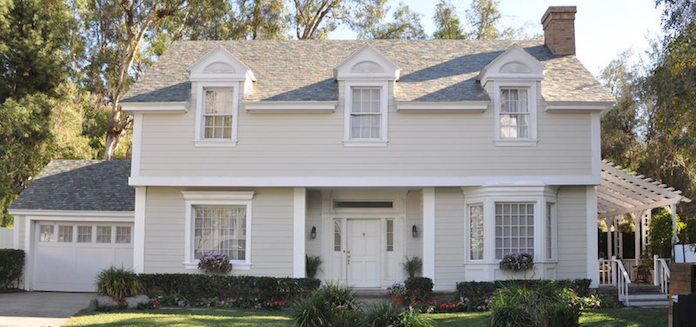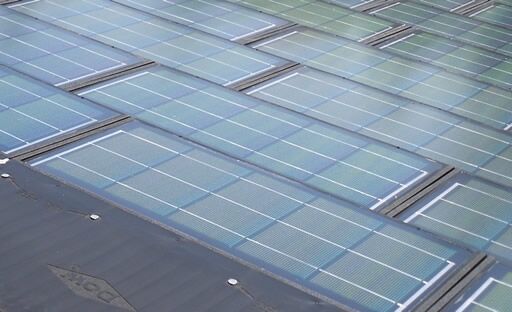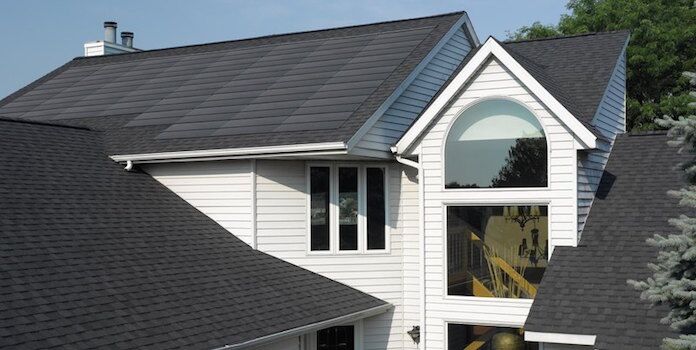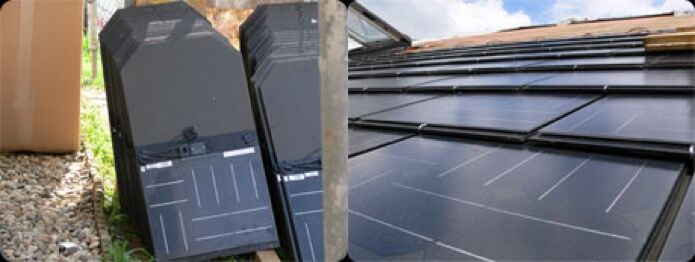Tesla solar roof! It costs how much in Quebec?, Tesla solar panel: what model? What price? What return?
Advantages and disadvantages of Tesla solar panels
Tesla’s solar roof shingles will soon make us rethink our perception of solar installations, but at what cost?
Tesla solar roof! How much does it cost?


**Update : Dated May 1, 2020, the cost of Tesla solar shingles is 30.$ 77 can the square foot (before taxes). For a standard roof of 1800 square feet, the total cost would be $ 55,386 can (before taxes). This cost is based on a roof with 35 % solar tiles. **
Tesla’s solar roof shingles will soon make us rethink our perception of solar installations, but at what cost?
When you imagine an installation on a roof, it is probably with conventional solar panels fixed on an aluminum structure. Tesla is now looking to modify your thought with their new product which is both a shingle and a solar panel.
Although technically they are not shingles, these Tesla and Solarcity solar tiles, (moreover the two companies were merged last year,) have the appearance of traditional shingles and are very good at home with the house. They are not to be confused with the panels with a low profile recently introduced by Tesla; These are real panels designed to cover the shingles so as to hide the fixing hardware.
Elon Musk said in October 2016 that the cost would be comparable to that of a typical roof. Speaking to the investors in November 2016, he offered the proposal: “… would you like to have a roof that has better appearance, lasts twice as long, costs less, and moreover, generates electricity?”He justifies that the cost would be less when combining the cost of a traditional roof and the savings projected on electricity services. But it remains that there are always skeptics which are not convinced that it is feasible.
Tom Werner, president of Sunpower, a Solarcity competitor, explains the reason why the implementation of solar shingles failed: the shingles overheated. The spacing between the roof and the conventional solar panels on the other hand offered a suitable ventilation thus avoiding overheating.
An important concern: what did Musk mean when he said that the cost of his shingles would be comparable to that of a “normal roof.”He had to specify that he was talking about the prices of the ceramic and concrete tiles which are quite expensive, between $ 400 and $ 2,000 the 100 square feet. Yet a normal roof in asphalt shingles costs on average $ 90 the 100 square feet. All this to say that the final cost, without specifying what kind of roof we compare, may be much higher.

Let’s examine the estimates found on the internet
1. Motley Fool
A columnist for Motley Fool did calculations to predict how solar shingles compare with a traditional roof. He estimates that based on a manufacturing cost of $ 0.30 The shingle equivalent to $ 588 the 100 square feet, is comparable to the ceramic or concrete tiles. But be aware that the costs of the installation are in addition: Tesla claims that the cost is $ 3 the watt installed … it’s $ 5,880 the 100 square feet, or for a 3,000 square feet house, your bill rises at $ 176,400.
2. Consumer Reports
… Have developed a calculation including early savings of electricity in order to be competitive with a traditional roof; They determined that a maximum expenditure of $ 73,500 would be necessary in order to be competitive with the roof in asphalt shingles, one of the less expensive solutions. According to information provided by associations specializing in the installation of roofs, and by presuming an average house with a roof of 3,000 square feet, the total cost of this asphalt shingle roof would be around $ 20,000. They then added in their calculation an invoice in annual costs of $ 2,000 (costs in theory eliminated by solar shingles), and the lifespan of the shingles being 30 years as stated by Tesla. After thirty years, savings should amount to around $ 60,000. When the PowerWall, which is part of the installation of the electricity storage system for non -solarized moments, and which costs $ 6500, savings would be reduced to $ 53,500.
Thus, a normal roof in asphalt shingles costing $ 20,000 and savings made of $ 53,500 with solar shingles, the Tesla option should not exceed $ 73,500 in order to be competitive.
3. Energyage
During an interview with Energyage In June 2019, a customer in northern California who had a Tesla solar roof installed as well as three Powerwall gave some details and an overview of the price of the installation. According to the customer in question, the entire installation cost $ 140,000 CAN, which included the full replacement of its 1,000 square feet roof and three PowerWall 2 (three 13 kWh batteries of autonomy each). Without the PowerWall, the replacement of the old roof and the addition of the solar roof cost $ 98,000 can, which amounts to $ 98 can. The system has a power of 10 kW and maintains the lights on at the customer’s home without the need for the 80% of time electrical network. His roof had several obstructions and had a high slope, which made the price of his system drastically inflate. It would therefore seem that the price of 30.$ 77 Can is for a roof without obstructions and with a constant and weak slope.
The data to consider
It is important to note that these are only estimates, and do not take into account geographic variations … This includes the apprehensions of Greentech Media that shingles would not all be able to produce electricity effectively due to the variability of ‘sunshine.
The calculations provided strongly suggest that having a Tesla Solar Roof we completely eliminate the invoice for electricity, rather than only reducing it. But estimates cannot take into account variations due to the complexity of the installation compared to that of a traditional solar installation. There are many factors that can significantly affect the total cost of the project.
Comparison of the costs of different types of solar shingles available on the Canadian market
Tesla Solar Roof is not a new concept. Other manufacturers have already attempted the production of solar shingles; Some have failed, and others are still on the market. One of the products from the Powerhouse Solar System of the Dow Chemical, only owed five years; At the time it was the product of choice but the company could not be up to consumers.
However, other companies continue with the production and installation of solar shingles. But it is difficult to find the costs being associated with it. It is important to note that the companies listed incorporate sunscreens and tiles with traditional materials, while Tesla’s solar shingles are designed to cover the entire roof, or even replace it. But Tesla competitors demands that a large part of the roof be covered with normal shingles (customer costs) in addition to the price of their systems.
1. Dow Chemical

Even if the company is no longer in business, it is worth taking a look because of information related to costs. Their Powerhouse system did not cover the entire roof; He arrived in super shingles which were well integrated with traditional shingles. An installation of 350 Powerhouse shingles would cost more than $ 20,000 and would reduce electricity consumption by 40-60%. In a Dow press release announced that “for an additional $ 27,480 expenditure above the cost of a traditional roof, you could perceive $ 58.640 energy saving over 25 years and also increase the value of your home by $ 33,000.»
2. Certain

The largest company still in operation that offers sundry shoes is certainly; It sells its Apollo II system through its accredited installers; This system would only cover part of your roof. Certainly guaranteed that you will get 60 watts of energy per solar tile for 25 years. It ensures protection against damage created by wind or shocks. Certainly, just like Dow, estimates that a layer of 350 -foot solar shingles would cost around $ 20,000 and decrease your electricity bill between 40 and 70%.
3. Sunslates

Sunslates is a product of Atlantis Energy Systems; A standard game includes 216 slate surfaces covered with a solar film covering 300 square feet of roofing. The company employs experienced installers. The very popular Eternit (trademark) tiles in Europe allow an excellent dripping. The costs are quite expensive; $ 13,000 per 100 square feet or $ 39,000 for a standard game, they are higher than the Apollo II of Certain. The Eastern Sales Director (United States) says that his product costs between $ 8 and $ 10 Watt, slightly below $ 13,000/$ 39,000 estimates 39,000. Always cheaper than some of Tesla’s products, it must always be remembered that Sunslates only covers part of the roof.
4. Sutenga

SUNTEGRA manufactures both solar shingles (whose appearance goes well with asphalt shingles) and solar tiles (whose appearance goes well with ceramic roofs). The two products have high efficiency and their design promotes good ventilation.
If solar shingles interest you, look closely at Tesla solar shingles.
This text is an extract from an English version from spring 2017.
Advantages and disadvantages of Tesla solar panels

Solar energy is clean and unlimited. With technological advances in the field, it is also more profitable and therefore cheaper.
Since 2020, the Tesla firm, known for the design and marketing of electric vehicles, has also launched in the electricity production sector with solar energy.
If photovoltaic panels are the benchmark in this area, Tesla innovates by highlighting Solar Roof or the roofs that are in the form of solar panels.
This is a new concept that allows us to do without the usual plates to maintain the aesthetic aspect of the roof. Initiated in the United States, this production method is expected in Europe.
Before the official announcement of its availability, here is what you need to know and what to expect concerning this new Tesla solar device.
Solar panels for roofing coating, what is it ?
Solar panels that come in the form of tiles are a cover solution which, in addition to ensuring the waterproofing of the roof, makes it possible to produce electricity or hot water.
They are composed of photovoltaic cells, but designed in order to imitate, as far as possible, the aesthetic aspect of traditional roofs.
There are different types of solar panels for the roof available on the market, namely:
- Photovoltaic plates that transform solar energy into electricity;
- Thermal panels that are used to produce domestic hot water;
- Hybrid solar devices that fulfill these two roles at the same time.
How the solar panels used as a roofing coating work ?
The roofs in solar plates work in the same way as the usual panels.
In other words, they contain photovoltaic cells that transform solar energy into electricity or calories (for hot water production). Powerwall batteries allow the current to store the current produced by the device, and to restore it if necessary.
To be effective, this type of coverage must have a large area exposed to the sun. Thus, it must ideally cover the entire roof to provide for the energy need for a household. In this way, they can guarantee the tightness of the roof while ensuring the homogeneity of the coating.
What are the advantages of choosing solar panels as a cover material ?
Many reasons justify the integration of solar panels into the roof to produce electricity.
The yield
If the production of solar energy electricity is often criticized for its performance, the progress made in the field have made it possible to solve this problem.
Thus, opting for this solar system makes it possible to reach self -consumption in a few months; to achieve substantial savings on the energy bill, and to resell the surplus of current.
The aesthetic aspect
The design is among the main advantages of opting for the roof in solar plate. Indeed, unlike the models installed in superimposed on the roof, this new design takes on a more discreet and more refined appearance.
It perfectly imitates the appearance of traditional tiles or slate roofs and does not deform the roof.
Ease of installation
Despite their specificities, the installation of a roof that produces electricity remains easy to make. Indeed, the installation is carried out in the same way as traditional materials.
For this, it is possible to call on a roofer. Connection to the electrical network requires the intervention of an electrician.
What are the points to be taken into account before opting for the installation of photovoltaic plates roofs ?
Despite the significant advantages, choosing the solar panel as a roofing material is not free from disadvantages.
The price
Although it is profitable in the long term, the installation of a solar plate roof is more expensive than that of traditional photovoltaic panels.
Indeed, if the cost of the installation varies around 200 euros for the two devices, the accessories and the equipment necessary for the integrated solar roofs influence the final price of the project.
In addition, the PowerWall battery costs more than 8,000 euros, installation included. To this is added VAT whose rate is 20 %.
However, it is possible to benefit from state subsidies and reduce this rate by initiating a RGE certified company for the installation of the installation.
Thus, despite an interesting king, this method of electricity production represents a substantial investment, especially since the system has not yet been marketed in Europe and its exact price remains unknown.
PLU restrictions
In general, the work that involves a change in the appearance of the roof, requires an authorization from the town hall and must respect the local urban plan or PLU plan.
This can be problematic for those who live in certain municipalities and who would like to adopt this material for their coverage.
In addition, there are many varieties of solar plates roofs that make it possible to comply as far as possible:
- The solar tile which is marketed by Tesla;
- The wide model;
- The slate with solar panel which ensures unequaled aesthetic quality;
- The transparent model.



